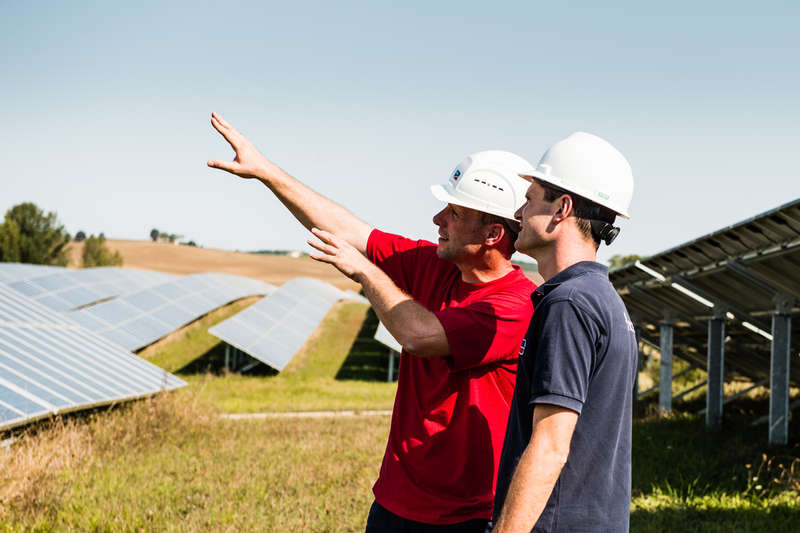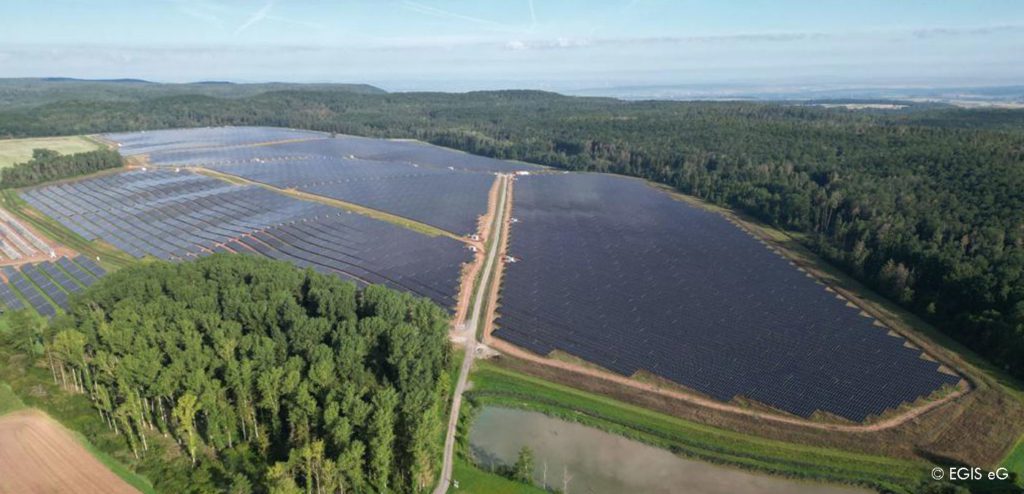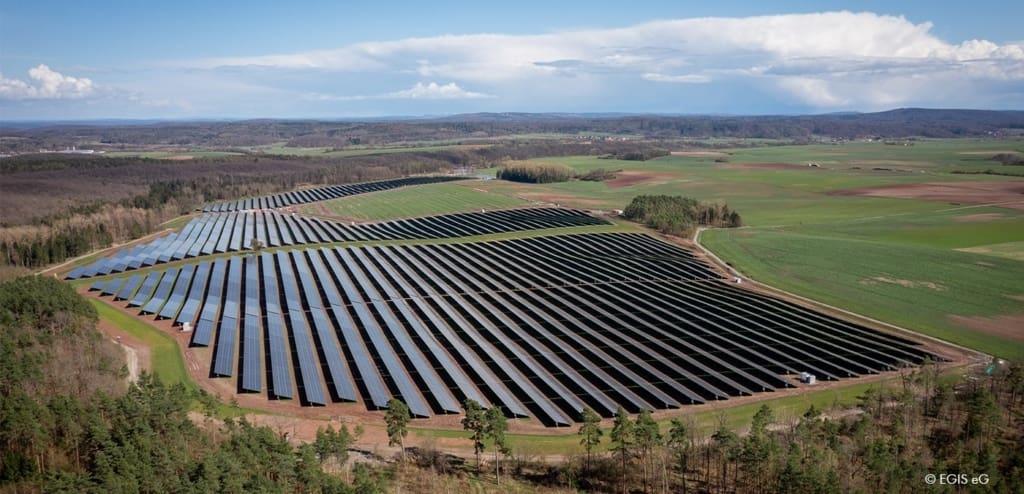Photovoltaics in the Crosshairs – The Real Reasons behind the Planned Cuts in Germany

The air is getting thinner for the major players of the conventional energy industry in Germany – their once stable business model has eroded over the years and, along with it, their influence over the highest echelons of political power. If they could have predicted eleven years ago that photovoltaics and wind energy would become as widespread and technologically advanced as they are today in Germany, then the Renewable Energy Sources Act (EEG) as an effective policy for subsidizing renewable energy would never have passed.
The fact is that the four major utility companies and their political backers were caught completely off guard by the rapid growth of renewables and the dawning reality of a clean energy revolution. Why photovoltaics would go on to become their number one enemy is obvious – PV not only has massive growth potential in Germany and abroad and is sinking in cost faster than any other renewable energy source, it also allows people to produce their own power for their own needs and hence offers the greatest potential for democratizing the electricity supply. In other words, photovoltaics threaten the economic and political standing of the conventional energy industry more than any of the other forms of renewable power generation.
What we are now seeing is an attempt to pull the emergency break – regardless of the costs. The plan is to apply maximum pressure on the government while feeding the public as many half-truths and preconceptions as possible. For it is an obligation, a necessity even, that the citizens, taxpayers and electricity consumers of Germany finally realize the futility of solar power subsidies, even though they are the ones who actually benefit the most from the clean energy revolution and the democratization of the electricity supply. This simple public relations strategy is inspired by a truism in the advertising world: people will believe even the biggest lies – as long as they are repeated often and loudly enough.
Photovoltaics Fact Check
The plain facts, however, paint a different picture. Official figures of the Leipzig Energy Exchange show that photovoltaics can already provide a significant portion of the electricity supply in Germany on certain days. A more important story, however, is the almost exponential growth of photovoltaic power generation, which has risen by more than six-fold over the past three years. Meanwhile, production costs are dropping so quickly that the current price of German solar power can already compete with conventional electrical power. In fact, electricity from big solar power plants is already cheaper than offshore wind energy, which is the preferred choice of the utility companies despite the difficulty of transporting electricity from the open seas to the customer. It is also clear from this that, given the current prices, further solar power subsidies will not cause any significant increase in the surcharge imposed by the Renewable Energy Sources Act (EEG). Quite the opposite, for the seeds of past subsidies are just now taking root and driving the cost of adding more power generation capacity down to very affordable levels. At least in this regard it is evident that the real reasons for the drastic cuts to the PV subsidies must be found elsewhere.
These are only two of the myriad reasons in favor of further photovoltaic growth backed by reasonable subsidies. One can safely assume that, in the coming days, many long discredited preconceptions will pop up in the media and be treated with great seriousness by various known members of the government and the energy industry*. With this in mind, here are the top ten preconceptions or “pseudo” arguments used against photovoltaics.
*RWE CEO Jürgen Großmann last revealed his expertise with Preconception No. 6 on January 18, 2012 (at the Handelsblatt Energy Industry Conference in Berlin)
Preconception 1: Solar power will hardly contribute anything to Germany’s energy supply.
Fact: At noon, on any given day with good weather, PV plants in Germany generate more power than all nuclear power plants currently in operation.
Critics insist that despite years of funding, photovoltaics contribute very little to Germany’s power supply. But they are overlooking the enormous growth rates in recent years, which have created huge potential power resources. According to the Federal Network Agency, nominal photovoltaic power totaled about 25 gigawatts in 2011. Under ideal irradiation conditions, this is equal to the output of more than 16 conventional block-unit power stations. As early as March 2011, the German PV plants were producing in good weather, for hours at a time, more power than all nuclear power plants on the power distribution grid.
Example: In June 2011, on Pentecost Sunday, photovoltaics supplied almost 30 percent of all electricity demand in Germany (see graphic). And even if solar power were to supply all of Germany’s power needs, it is calculated that it would require only 1.1% of the country’s land. At the SMA website, you can follow the estimated current output of all German PV plants in real time. A calendar function also lets you view past data.
Preconception 2: Too much solar power overloads the power distribution grid.
Fact: PV plants put a relatively small load on the power distribution grid and even provide relief.
A survey of distribution grid operators conducted by the German Solar Industry Association in autumn 2010 shows that, comparatively speaking, further expansion of photovoltaics will not have a significant impact on the German power distribution grid. This is particularly true in cities and densely populated areas where the existing grid infrastructure is adequate. In many cases, solar power even works to relieve the load on the power distribution grid. For example, photovoltaics have the unique ability to match the moment of maximum energy production to the moment of maximum energy demand. In concrete terms, this means that when solar power is being generated it is also being used in the power distribution grid. Likewise, solar power is, for the most part, generated at decentralized locations, that is – directly where it is consumed. The self-consumption of solar power from a rooftop PV plant relieves the power distribution grid because the solar power replaces power from the power distribution grid that would otherwise need to be transported to the location.
It is precisely for this reason that Germany has subsidized self-consumption since 2009. In addition, modern reactive power-capable inverters can significantly reduce the load on the grid at the termination point and nearly double the amount of solar power fed in, all with the same grid infrastructure. Installing new, more powerful high-voltage lines is certainly practical and necessary for a full-scale energy revolution, however it is not primarily attributable to the expansion of photovoltaics.
Preconception 3: Building PV plants is pointless because other renewable sources generate energy at significantly lower cost.
Fact: Solar power is indispensable for the energy revolution and is becoming more cost-effective all the time.
It is true that solar power is currently more expensive than wind power or hydropower. But first of all, we need all renewable energy sources to bring about an energy revolution. Only by combining their various strengths will wind energy, photovoltaics, bioenergy, and hydropower be able to supplement one another. Moreover, the extraordinary characteristics of photovoltaics give it almost unlimited potential for power generation: PV plants work almost anywhere, require no moving parts, and can be scaled to nearly any dimensions. Lastly, although the remuneration for solar power is still higher than that of other renewable energy sources. The costs in the solar power industry, and hence the feed-in tariffs for new plants, continue to drop at a rapid pace. Since 2006, the cost of PV plants has dropped by more than 58 percent and over the long term, it is expected to become the cheapest form of power generation.
Preconception 4: Solar power is much more expensive than power generated by coal-fired or nuclear power plants.
Fact: This is true only if the billions of euros in environmental damage that they cause are not considered.
Even if those costs are not included in the price of electricity, it would be naive to ignore the damage to the environment, climate, and health caused by conventional power sources. In 2010 alone, renewable energy saved roughly 120 million tons of carbon dioxide, even factoring in the small amount of carbon dioxide emitted in producing it. In monetary terms, the damage to the climate and environment prevented by this process saved the German economy more than EUR 8 billion — and for 2011, this total will be notably even higher.
The primary culprits for CO2 emissions are coal-fired power plants. Although nuclear power creates less CO2 emissions, the uranium mining process, plant operations, and storage of radioactive waste for up to a million years pose huge environmental risks. And a major nuclear accident would cause astronomical amounts of damage while the total insurance coverage for all the nuclear power plants in Germany is equal to the liability insurance for 50 automobiles on any given supermarket parking lot.
Preconception 5: only large-scale power plants can guarantee power supply.
Fact: The energy supply of the future is decentralized.
All renewable energy sources, and photovoltaics in particular, are opening the door to a new age of energy production. This calls for a transition to decentralized energy production, a secure energy supply, and climate neutrality. What does this mean? In the future, energy will be provided on location by a vast array of producers of different sizes, rather than remaining in the hands of a few major utilities. This allows for reduced dependency on politically unstable oil-producing countries and supply routes subject to possible attacks — of course a significant benefit for society as a whole. These changes will transform the existing supply structure into a modern energy grid that is able to distribute fluctuating amounts of energy everywhere without significant loss while also incorporating electric vehicles (as part of the “smart grid” concept). Furthermore, an industry study** has shown that as early as 2017 it will be possible to operate the first PV plants in Germany profitably without any Renewable Energy Sources Act (EEG) subsidies. For the two billion people across the globe who live with no connection to a power grid, photovoltaics offer the only prospect for benefiting from electrical power. In places where conventional large-scale PV plants and distribution grids are not practical, a reliable and convenient energy supply can be established with off-grid PV plants.
Even now, this means cheaper energy than what today’s diesel generators can produce — and that does not even take into account environmental aspects or the safety of producing the energy supply. These systems offer affected communities a unique opportunity for development, along with all of the other advantages that renewable energy sources offer.
** PV roadmap of the German Solar Industry Association, November 2010
Preconception 6: The sun does not shine enough in Germany.
Fact: Even in Central Europe, photovoltaics are absolutely practical and worthwhile.
There are people who think that generating solar power in rainy Germany is foolish and reject it for this reason alone. After all, no one tries to grow bananas at the North Pole. However, the fact is that even in northern Germany, 40 square meters of PV modules are enough to meet the annual electricity requirements of an average household***. Incidentally, it is easy to document these figures — through Germany’s more than a million PV plant providers. Those who would like detailed information on this can use SMA’s free Sunny Design planning software to estimate the energy yield of any PV plant — for almost any location in Germany.
*** An average energy yield in Germany from 900 to 1,200 kWh per year and kW plant peak power is realistic.
Preconception 7: The only people benefiting from photovoltaics are homeowners and investors.
Fact: Solar power is creating many jobs with a future.
Renewable energy companies now employ roughly 370,000 people — and that figure is on the rise. Jobs are being created in industrial operations, small and medium-sized enterprises, and naturally in the trades. Photovoltaics stands out in this respect: Most PV plants are installed by small trade businesses, and also call on electronics stores, manufacturers of accessories, and planning offices. The German PV industry alone, including large-scale manufacturers of solar technology, employs more than 100,000 people. This means that the added value afforded by PV plants is focused in Germany, despite global competition. Unlike their peers in many other industries, almost all employees in photovoltaics companies have secure prospects for the future.
Preconception 8: Subsidies for renewable energies hurt Germany’s standing as a business location.
Fact: Renewable energies save billions of euros in imported energy and boost the domestic economy.
Oil from Norway and Libya, gas from Russia, uranium ore from African mines: These conventional energy carriers must come from somewhere and certainly do not come free of charge. In 2009, roughly EUR 54 billion went to other countries for fuel to operate conventional power plants — a sum that could be saved, in its entirety, by using a renewable power supply. The import of raw materials that could be prevented by using renewable energy sources cost us about EUR 7.4 billion in 2010. Expenditures for renewable energies, on the other hand, have largely remained within Germany. In addition, German industry holds a significant technological lead in many areas of renewable energy production and is able to export its products profitably throughout the world. In 2010 alone, SMA supplied solar technology abroad to the tune of EUR 860 million.
Preconception 9: Photovoltaics in particular pushes power prices up.
Fact: Solar power in particular lowers purchase prices on the power exchange.
In fact, a portion of renewable energy production costs is incorporated into the price of electricity through what is known as the Renewable Energy Sources Act (EEG) levy. While the levy does not include the cost-reducing effects of renewable energy sources, there is no question they exist. The best example is the “merit order effect” to which the photovoltaics industry contributes particularly heavy. What is behind this? Put simply, the effect describes a price reduction mechanism on the Leipzig Power Exchange. This is where the wholesale price is determined daily for the following day – timed to the minute and depending on supply and demand.
The solar power fed into the power distribution grid lowers this price on a regular basis. Unfortunately for the energy companies, this price generally goes into effect at noon — in other words, precisely at the time when the stock price is at its highest and the business is at its most lucrative. The feed-in of solar power thus regularly deprives the operators of conventional power plants of millions of euros in profits — allowing the end customer to theoretically benefit from an exchange price that is dropping sharply and that compensates somewhat for the EEG levy. Unfortunately, these benefits have remained theoretical to date, because the four largest power utilities are — directly or indirectly — also the largest buyers on the power exchange. And they have not yet passed on these stock price reductions to the end customer.
Preconception 10: Renewable energy sources are just an obsession of eco-freaks.
Fact: There is no alternative to renewable energy sources because all other energy carriers are finite.
Although this is glaringly obvious it is consistently ignored: Fossil fuels are finite, as are nuclear fuels like uranium. Furthermore, they have been largely used up, and extracting the ever-diminishing resources is becoming more and more expensive. For this reason, society has no alternative but to find and use other sources of energy. The solution to this problem has long been within reach: Renewable energies are inexhaustible and environmentally friendly, and are available to nearly everyone in the world and in huge quantities. Moreover, the technology needed to use it continues to become increasingly cost-effective — due first and foremost to the German Renewable Energy Sources Act (EEG).
Sources:
- German Agency for Renewable Energies: Fact sheet “Volkswirtschaftlicher Nutzen des Ausbaus Erneuerbarer Energien” [Economic benefits of the expansion of renewable energies]. Berlin, October 2010
- Federal German Ministry for Economics and Technology (BMWi): “Reserven, Ressourcen und Verfügbarkeit von Energierohstoffen 2002.” [Reserves, Resources and Availability of Resources 2002]. Berlin, 2002
- German Renewable Energy Federation (BEE): “Jahreszahlen Erneuerbare Energien 2010” [Yearly figures for renewable energies, 2010]. Berlin, February 2011
- German Aerospace Center (DLR); Fraunhofer Institute for Wind Energy and Energy System Technology (IWES); Ingenieurbüro für neue Energien [Engineering firm for renewable energy sources, IfnE]: Entwicklung der EEG-Vergütungen, EEG-Differenzkosten und der EEG-Umlage bis zum Jahr 2030 auf Basis des Leitszenario 2010 [Trends in German Renewable Energy Sources Act fees, German Renewable Energy Sources Act differential costs and the EEG contribution projected to 2030 on the basis of the 2010 lead scenario]. Stuttgart, Kassel, Teltow, June 2010.
- Green Budget Germany: Hintergrundpapier “Billiger Strom aus Atom und Kohle?” – Staatliche Förderungen 1970 – 2008″. [Fact sheet: Cheaper electricity from nuclear and coal-fired sources? – government subsidies 1970 – 2008] Berlin, October 2010
- Fraunhofer Institute for Systems and Innovation Research, Institute of Economic Structures Research (GWS mbH), Institut für ZukunftsEnergieSysteme [Institute for future energy systems, IZES], German Institute for Economic Research (DIW): “Einzel- und gesamtwirtschaftliche Analyse von Kosten- und Nutzenwirkungen des Ausbaus Erneuerbarer Energien im deutschen Strom- und Wärmemarkt” [Micro- and macroeconomic analysis of cost and benefit effects of the expansion of renewable energies in the German electrical and heating sector]. Karlsruhe, Osnabrück, Saarbrücken, Berlin, May 2010.
- Institute for Energy Economics and the Rational Use of Energy (IER): “Verträglichkeit von erneuerbaren Energien und Kernenergie im Erzeugungsportfolio”. [Compatibility of renewable energies and nuclear power in the generation portfolio. Technical and economical aspects] Stuttgart, October 2009.
- German Advisory Council on the Environment (SRU), “Stellungsnahme Nr. 15: 100% erneuerbare Stromversorgung bis 2050.” [Statement No. 15: Climate-friendly, reliable, affordable: 100% renewable electricity supply by 2050. Berlin, May 2010.]
- German Advisory Council on Global Change (WBGU)
- Wuppertal Institute for Climate, Environment, and Energy: Kurzanalyse zur aktuellen Diskussion um die mit dem Ausbau der erneuerbaren Energien in der Stromversorgung verbundenen Kosten und Nutzen [Brief analysis of the current discussion of costs and benefits associated with the expansion of renewable energies in electricity supply]. Wuppertal, October 2010.
Glossary
German Federal Network Agency
The German Federal Network Agency in Bonn is a high-level federal authority responsible for competition of network markets (electricity, gas, and telecommunications). Since the beginning of 2009, it has also kept a registry listing all PV plants that feed into the power distribution grid including their location and output.
Degression
Although compensation for renewable energy is always paid in 20-year cycles, every January, the rates for plants going live on the grid for the first time drop by a certain percentage (in 2010 there was an additional reduction at mid-year). In this way, degression allows continuous drops in plant charges and ultimately, in combination with the feed-in tariff, ensures that power from renewable energy sources becomes progressively cheaper and thereby more competitive.
Renewable Energy Sources Act(in German “Erneuerbare-Energien-Gesetzt”, abbreviated to “EEG”)
Since 2000, the EEG has supported the development and spread of renewable energy sources in Germany. It’s key element provides for the payment of a feed-in tariff for power from renewable resources for a period of 20 years, starting from the commissioning of the plant. Because the plant’s costs decrease continuously as a result of higher unit counts and technological advances, the purchase prices for new power generation equipment are reduced annually. Internationally, Germany’s Renewable Energy Sources Act is viewed as a model for success and has now been adopted by more than 40 countries.
German Renewable Energy Sources Act contribution
The EEG contribution allows the costs of the EEG support to be reallocated to the price of electricity. In other words, it is not a subsidy (which represents tax-funded aid). The costs represent the difference resulting from the feed-in tariff paid and the exchange price received in each case. Because the feed-in tariff for new plants drops annually, the EEG contribution can only go down over the medium term – even if renewable energy expands further.
Self-consumption
Self-consumption of solar electricity has been subsidized since 2009 because it reduces the load on the power distribution grid and also helps to integrate more PV power into the existing power grid structures. As of July 1, 2010, support was increased to cover the eventuality that more than 30 percent of solar energy will be used locally every year. For private energy consumers, promoting self-consumption is almost always worthwhile; all that is needed is a third electricity meter or a bidirectional meter instead of the consumption meter.
Merit order effect
With the so-called Merit-order-Effect, electricity from renewable sources provides falling prices at the energy exchange (EXX) in Leipzig. This is because the German Renewable Energy Sources Act gives priority to power from renewable energy sources when it is fed into the grid. This means that in many situations, power plant operators need no longer fall back on peak load power plants, which are relatively costly to operate, in order to meet demand. However, because the power price is always determined by the most expensive power plant in use (merit order), less frequent use of these plants causes the average power price to drop. Because solar power is available daily at the time when demand for power peaks, it can cause a particularly strong merit order effect. Whether or not end consumers benefit from the merit order effect depends on whether the electricity industry passes the power exchange reduction on to them.
Grid parity
The term “grid parity” describes the moment from which solar power is cheaper than the end consumer price of conventionally generated electricity. Because this price follows a rising trend while the costs for solar power continue to sink, Germany will probably reach grid parity as early as 2013. One reason for this is the fact that solar power from our own rooftops competes with electricity from big power plants, which has to be transported across vast distances and therefore is much more expensive when it comes out of the socket. Grid parity on power plant level will not come for several more years.
Smart grid
“Smart grid” refers to a way of connecting and managing geographically distributed power generators, batteries, and consumers in combination with a correspondingly flexible network infrastructure for energy and data. The differences in structure and potential uses between a smart grid and a conventional, centralized power supply grid are somewhat comparable to those between the old analog TV-cable network and the internet.
Power exchange (EXX)
The EEX power exchange in Leipzig is an organized market for trading electrical energy that functions as the Deutsche Börse does for stocks: Buyers and sellers of quantities of electricity negotiate prices that are determined by supply and demand, forecasts and the timeframe estimated in each case. Quantities of electricity are traded not only for long-term supply agreements but also, in what is known as “day-ahead trading,” those for individual hours of the next day – on the basis of predicted energy requirements. The greater these requirements are, the more expensive the additional power plants needed to generate it and the higher the price for that interval.







A really great article. Thank you.
A brilliantly written piece – most of which is directly transferrable to the UK. Thanks!